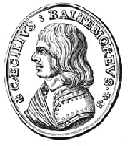


|
|||||||||
| Book
Review
by Joshua Mason Driver, Robert J., Jr. First and Second Maryland Infantry, C.S.A. Bowie: Heritage Books, 2003. Pp. "xx, 240." Cloth, illus., indexed, bibliog. ISBN 1-58549-901-3 Price $35.00, plus s+h. They were called "Orphans"--men who enlisted to fight for the Confederate States of America but who lived in one of the Border States of Maryland, Kentucky or Missouri. These men were seen as soldiers who did not have a home in a war that many southerners and northerners alike placed so much emphasis on protecting. In Robert J. Driver, Jr.'s new book, First and Second Maryland Infantry, C.S.A., he painstakingly examines the record of two of these units that came from the farmlands and cities throughout Maryland. This is the first book written about these two units, and is Driver's second one devoted to Maryland units that fought for the Confederacy, and his first devoted to Maryland Calvary units. The best aspects of this book are the firsthand accounts collected by Driver. In describing an attempt by the First Maryland Infantry to capture a hospital that Union soldiers were using for protection during the battle of Front Royal, VA, Driver quotes from a soldier named John Post: "they fired at us from the hospital windows and doors, wounding six of our Regiment. We charged them, and such a getting out, you never did see. We drove them thro' the town, all the time ladies offered us [food and drink] going thro' and hate to think how foolish I was not stopping and getting some." (p. 72) Driver quotes one comical |
||
| diarist,
a member of the Second Maryland Infantry, during the last winter of the
war: "It is bitter cold and we are in tatters. I have the waist of my pantaloons
left, and my only pair of cotton drawers are not the thickest material....
I often wonder what my little Baltimore girl would say if she saw me in
this plight. Guess she'd look for some other fellow." (p. 305) Accounts
like this make the book very enjoyable and give the reader a clear view
as to how the men thought and lived during the war.
In general, Driver does an excellent job of telling the story of the two regiments. Not as well explained are the rest of the corps and the battles themselves. For example, during the account of the Battle of Gettysburg nothing is written about why the men were ordered to take Culp's Hill. During the Battle of Cold Harbor, VA in June 1863, the Second Maryland Infantry without explicit orders plugged a hole on the Confederate army's right flank, thus preventing more Federal troops from going through. Events like this need to be discussed more thoroughly in the book in order to make the reader more aware of the importance of what the Maryland units actually accomplished. An interesting feature of the book is the almost 200 page section devoted to Muster Rolls of the First and Second Maryland Infantry, in which are listed the name, rank, company, regiment and service record of each soldier. The service records provide information about enlistments; battles where soldiers were wounded, killed, or captured;
(continued on Page 2) |
||
